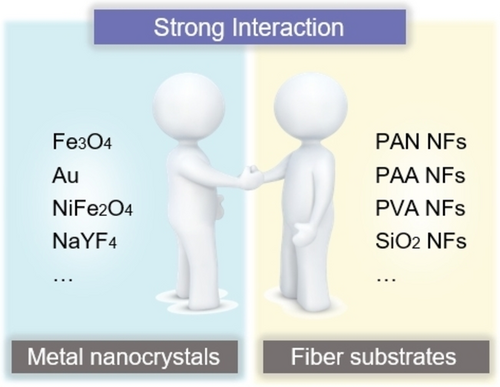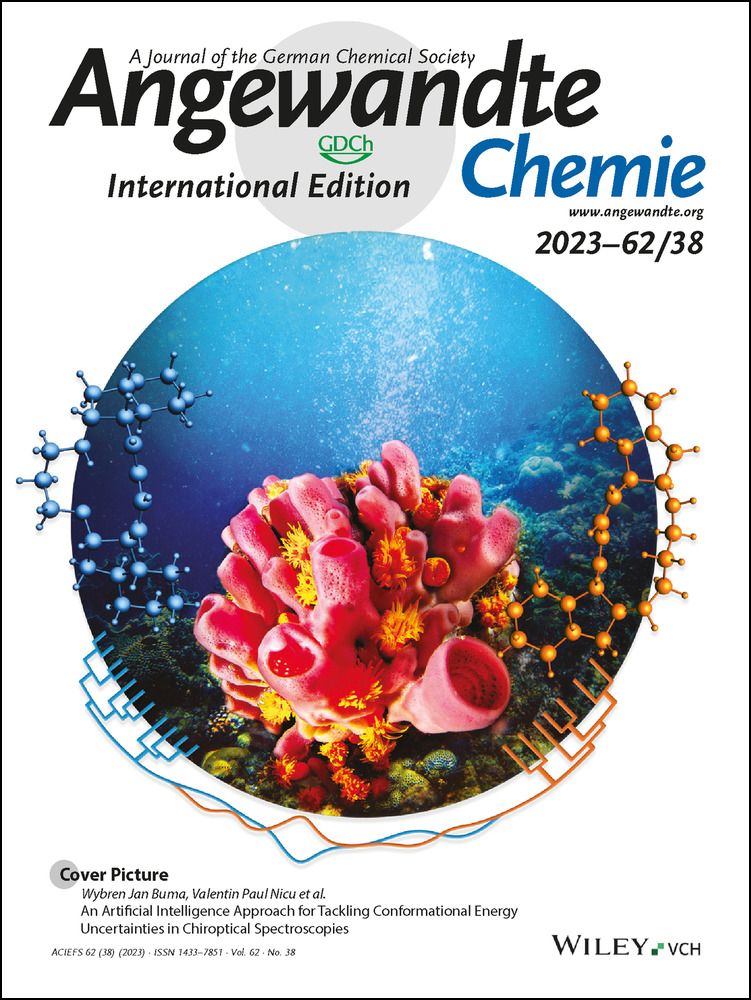Interfacial Assembly of Nanocrystals on Nanofibers with Strong Interaction for Electrocatalytic Nitrate Reduction
Fangzhou Zhang
State Key Laboratory for Modification of Chemical Fibers and Polymer Materials, College of Materials Science and Engineering, Donghua University, Shanghai, 201620 P. R. China
Search for more papers by this authorJiamei Luo
State Key Laboratory for Modification of Chemical Fibers and Polymer Materials, College of Materials Science and Engineering, Donghua University, Shanghai, 201620 P. R. China
Search for more papers by this authorJunliang Chen
State Key Laboratory for Modification of Chemical Fibers and Polymer Materials, College of Materials Science and Engineering, Donghua University, Shanghai, 201620 P. R. China
Search for more papers by this authorHongxia Luo
State Key Laboratory for Modification of Chemical Fibers and Polymer Materials, College of Materials Science and Engineering, Donghua University, Shanghai, 201620 P. R. China
Search for more papers by this authorMiaomiao Jiang
State Key Laboratory for Modification of Chemical Fibers and Polymer Materials, College of Materials Science and Engineering, Donghua University, Shanghai, 201620 P. R. China
Search for more papers by this authorChenxi Yang
State Key Laboratory for Modification of Chemical Fibers and Polymer Materials, College of Materials Science and Engineering, Donghua University, Shanghai, 201620 P. R. China
Search for more papers by this authorCorresponding Author
Prof. Hui Zhang
State Key Laboratory for Modification of Chemical Fibers and Polymer Materials, College of Materials Science and Engineering, Donghua University, Shanghai, 201620 P. R. China
Search for more papers by this authorProf. Jun Chen
ARC Centre of Excellence for Electromaterials Science, Intelligent Polymer Research Institute (IPRI), Australian Institute of Innovative Materials (AIIM), University of Wollongong, Wollongong, NSW 2522 Australia
Search for more papers by this authorProf. Angang Dong
Collaborative Innovation Center of Chemistry for Energy Materials, Shanghai Key Laboratory of Molecular Catalysis and Innovative Materials, and Department of Chemistry, Fudan University, Shanghai, 200433 China
Search for more papers by this authorCorresponding Author
Prof. Jianping Yang
State Key Laboratory for Modification of Chemical Fibers and Polymer Materials, College of Materials Science and Engineering, Donghua University, Shanghai, 201620 P. R. China
Search for more papers by this authorFangzhou Zhang
State Key Laboratory for Modification of Chemical Fibers and Polymer Materials, College of Materials Science and Engineering, Donghua University, Shanghai, 201620 P. R. China
Search for more papers by this authorJiamei Luo
State Key Laboratory for Modification of Chemical Fibers and Polymer Materials, College of Materials Science and Engineering, Donghua University, Shanghai, 201620 P. R. China
Search for more papers by this authorJunliang Chen
State Key Laboratory for Modification of Chemical Fibers and Polymer Materials, College of Materials Science and Engineering, Donghua University, Shanghai, 201620 P. R. China
Search for more papers by this authorHongxia Luo
State Key Laboratory for Modification of Chemical Fibers and Polymer Materials, College of Materials Science and Engineering, Donghua University, Shanghai, 201620 P. R. China
Search for more papers by this authorMiaomiao Jiang
State Key Laboratory for Modification of Chemical Fibers and Polymer Materials, College of Materials Science and Engineering, Donghua University, Shanghai, 201620 P. R. China
Search for more papers by this authorChenxi Yang
State Key Laboratory for Modification of Chemical Fibers and Polymer Materials, College of Materials Science and Engineering, Donghua University, Shanghai, 201620 P. R. China
Search for more papers by this authorCorresponding Author
Prof. Hui Zhang
State Key Laboratory for Modification of Chemical Fibers and Polymer Materials, College of Materials Science and Engineering, Donghua University, Shanghai, 201620 P. R. China
Search for more papers by this authorProf. Jun Chen
ARC Centre of Excellence for Electromaterials Science, Intelligent Polymer Research Institute (IPRI), Australian Institute of Innovative Materials (AIIM), University of Wollongong, Wollongong, NSW 2522 Australia
Search for more papers by this authorProf. Angang Dong
Collaborative Innovation Center of Chemistry for Energy Materials, Shanghai Key Laboratory of Molecular Catalysis and Innovative Materials, and Department of Chemistry, Fudan University, Shanghai, 200433 China
Search for more papers by this authorCorresponding Author
Prof. Jianping Yang
State Key Laboratory for Modification of Chemical Fibers and Polymer Materials, College of Materials Science and Engineering, Donghua University, Shanghai, 201620 P. R. China
Search for more papers by this authorGraphical Abstract
An interfacial assembly method to arrange metal nanocrystals on fiber substrates with strong interaction is demonstrated for optimized electrocatalytic performance. The obtained Fe/NFs assembly structure is proposed as an efficient electrocatalyst for nitrate reduction to N2, which achieves a high nitrate removal capacity of 2317 mg N/g Fe and N2 selectivity up to 97.2 %.
Abstract
One-dimensional fiber architecture serves as an excellent catalyst support. The orderly arrangement of active materials on such a fiber substrate can enhance catalytic performance by exposing more active sites and facilitating mass diffusion; however, this remains a challenge. We developed an interfacial assembly strategy for the orderly distribution of metal nanocrystals on different fiber substrates to optimize their electrocatalytic performance. Using electrochemical nitrate reduction reaction (NO3−RR) as a representative reaction, the iron-based nanofibers (Fe/NFs) assembly structure achieved an excellent nitrate removal capacity of 2317 mg N/g Fe and N2 selectivity up to 97.2 %. This strategy could promote the rational design and synthesis of fiber-based electrocatalysts.
Open Research
Data Availability Statement
The data that support the findings of this study are available on request from the corresponding author. The data are not publicly available due to privacy or ethical restrictions.
Supporting Information
As a service to our authors and readers, this journal provides supporting information supplied by the authors. Such materials are peer reviewed and may be re-organized for online delivery, but are not copy-edited or typeset. Technical support issues arising from supporting information (other than missing files) should be addressed to the authors.
| Filename | Description |
|---|---|
| anie202310383-sup-0001-misc_information.pdf2.3 MB | Supporting Information |
Please note: The publisher is not responsible for the content or functionality of any supporting information supplied by the authors. Any queries (other than missing content) should be directed to the corresponding author for the article.
References
- 1
- 1aW. Teng, N. Bai, Y. Liu, Y. Liu, J. Fan, W.-x. Zhang, Environ. Sci. Technol. 2018, 52, 230–236;
- 1bS. Zhu, E. P. Delmo, T. Li, X. Qin, J. Tian, L. Zhang, M. Shao, Adv. Mater. 2021, 33, 2005484.
- 2
- 2aF. Zhang, P. C. Sherrell, W. Luo, J. Chen, W. Li, J. Yang, M. Zhu, Adv. Sci. 2021, 8, 2102859;
- 2bZ. Zhang, X. Wu, Z. Kou, N. Song, G. Nie, C. Wang, F. Verpoort, S. Mu, Chem. Eng. J. 2022, 428, 131133;
- 2cC.-L. Zhang, S.-H. Yu, Chem. Soc. Rev. 2014, 43, 4423–4448.
- 3
- 3aF. Zhang, J. Chen, G. G. Wallace, J. Yang, Prog. Mater. Sci. 2023, 133, 101069;
- 3bK. Ma, K. B. Idrees, F. A. Son, R. Maldonado, M. C. Wasson, X. Zhang, X. Wang, E. Shehayeb, A. Merhi, B. R. Kaafarani, T. Islamoglu, J. H. Xin, O. K. Farha, Chem. Mater. 2020, 32, 7120–7140.
- 4
- 4aM. Inagaki, Y. Yang, F. Kang, Adv. Mater. 2012, 24, 2547–2566;
- 4bP. S. Kumar, J. Sundaramurthy, S. Sundarrajan, V. J. Babu, G. Singh, S. I. Allakhverdiev, S. Ramakrishna, Energy Environ. Sci. 2014, 7, 3192–3222.
- 5
- 5aQ. Mo, W. Zhang, L. He, X. Yu, Q. Gao, Appl. Catal. B 2019, 244, 620–627;
- 5bM.-Q. Wang, C. Ye, H. Liu, M. Xu, S.-J. Bao, Angew. Chem. Int. Ed. 2018, 57, 1963–1967;
- 5cY. Zeng, P. X. Sun, Z. Pei, Q. Jin, X. Zhang, L. Yu, X. W. Lou, Adv. Mater. 2022, 34, 2200342;
- 5dZ.-Y. Wu, P. Zhu, D. A. Cullen, Y. Hu, Q.-Q. Yan, S.-C. Shen, F.-Y. Chen, H. Yu, M. Shakouri, J. D. Arregui-Mena, A. Ziabari, A. R. Paterson, H.-W. Liang, H. Wang, Nat. Synth. 2022, 1, 658–667;
- 5eX. Liang, H. Zhu, X. Yang, S. Xue, Z. Liang, X. Ren, A. Liu, G. Wu, Small Struct. 2023, 4, 2200202.
- 6
- 6aS. Han, Y. Hao, Z. Guo, D. Yu, H. Huang, F. Hu, L. Li, H.-Y. Chen, S. Peng, Chem. Eng. J. 2020, 401, 126088;
- 6bY. Zhong, Y. Lu, Z. Pan, J. Yang, G. Du, J. Chen, Q. Zhang, H. Zhou, J. Wang, C. Wang, W. Li, Adv. Funct. Mater. 2021, 31, 2009853.
- 7T. Tran-Phu, R. Daiyan, Z. Fusco, Z. Ma, R. Amal, A. Tricoli, Adv. Funct. Mater. 2020, 30, 1906478.
- 8
- 8aK. Xu, H. Cheng, H. Lv, J. Wang, L. Liu, S. Liu, X. Wu, W. Chu, C. Wu, Y. Xie, Adv. Mater. 2018, 30, 1703322;
- 8bY. Tong, H. Guo, D. Liu, X. Yan, P. Su, J. Liang, S. Zhou, J. Liu, G. Q. Lu, S. X. Dou, Angew. Chem. Int. Ed. 2020, 59, 7356–7361;
- 8cW. Chen, X. Yang, Z. Chen, Z. Ou, J. Hu, Y. Xu, Y. Li, X. Ren, S. Ye, J. Qiu, J. Liu, Q. Zhang, Adv. Funct. Mater. 2023, 33, 2300512.
- 9
- 9aL. Su, F. Zhang, L. Wang, X. Fang, W. Jiang, J. Yang, Chem. Commun. 2021, 57, 6740–6743;
- 9bB. Wang, J. Zou, X. Shen, Y. Yang, G. Hu, W. Li, Z. Peng, D. Banham, A. Dong, D. Zhao, Nano Energy 2019, 63, 103851.
- 10
- 10aG. Wu, T. Li, Z. Wang, M. Li, B. Wang, A. Dong, Angew. Chem. Int. Ed. 2020, 59, 20628–20635;
- 10bT. Li, X. Xia, G. Wu, Q. Cai, X. Lyu, J. Ning, J. Wang, M. Kuang, Y. Yang, M. Pica Ciamarra, R. Ni, D. Yang, A. Dong, Sci. Adv. 2022, 8, eabq0969;
- 10cS. Xue, G. Wu, M. Li, Z. Liu, Y. Deng, W. Han, X. Lv, S. Wan, X. Xi, D. Yang, A. Dong, Nano Res. 2022, 15, 255–263;
- 10dX. Wang, J. Zhuang, Q. Peng, Y. Li, Nature 2005, 437, 121–124.
- 11
- 11aQ. Cai, J. Wang, Y. Jiao, T. Li, Y. Xia, M. Li, Y. Yang, G. Wu, J. Zou, J. Hu, A. Dong, D. Yang, Small 2021, 17, 2101173;
- 11bM. Li, G. Wu, Z. Liu, X. Xi, Y. Xia, J. Ning, D. Yang, A. Dong, J. Hazard. Mater. 2020, 397, 122766.
- 12F. Nakagawa, M. Saruyama, R. Takahata, R. Sato, K. Matsumoto, T. Teranishi, J. Am. Chem. Soc. 2022, 144, 5871–5877.
- 13
- 13aY. Qiao, P. Yuan, Y. Hu, J. Zhang, S. Mu, J. Zhou, H. Li, H. Xia, J. He, Q. Xu, Adv. Mater. 2018, 30, 1804504;
- 13bQ. Zhou, Z. Shen, C. Zhu, J. Li, Z. Ding, P. Wang, F. Pan, Z. Zhang, H. Ma, S. Wang, H. Zhang, Adv. Mater. 2018, 30, 1800140;
- 13cH. Li, M. Hu, L. Zhang, L. Huo, P. Jing, B. Liu, R. Gao, J. Zhang, B. Liu, Adv. Funct. Mater. 2020, 30, 2003198.
- 14H. Xu, J. Chen, Z. Zhang, C.-T. Hung, J. Yang, W. Li, Adv. Mater. 2023, 35, 2207522.
- 15W. Duan, G. Li, Z. Lei, T. Zhu, Y. Xue, C. Wei, C. Feng, Water Res. 2019, 161, 126–135.
- 16H. Zhang, C. Wang, H. Luo, J. Chen, M. Kuang, J. Yang, Angew. Chem. Int. Ed. 2023, 62, e202217071.
- 17Y. Wang, H. Li, W. Zhou, X. Zhang, B. Zhang, Y. Yu, Angew. Chem. Int. Ed. 2022, 61, e202202604.
- 18S.-H. Bae, J.-E. Kim, H. Randriamahazaka, S.-Y. Moon, J.-Y. Park, I.-K. Oh, Adv. Energy Mater. 2017, 7, 1601492.
- 19J. Park, K. An, Y. Hwang, J.-G. Park, H.-J. Noh, J.-Y. Kim, J.-H. Park, N.-M. Hwang, T. Hyeon, Nat. Mater. 2004, 3, 891–895.
- 20B.-H. Wu, H.-Y. Yang, H.-Q. Huang, G.-X. Chen, N.-F. Zheng, Chin. Chem. Lett. 2013, 24, 457–462.
- 21S. Sun, H. Zeng, D. B. Robinson, S. Raoux, P. M. Rice, S. X. Wang, G. Li, J. Am. Chem. Soc. 2004, 126, 273–279.
- 22C. Homann, L. Krukewitt, F. Frenzel, B. Grauel, C. Würth, U. Resch-Genger, M. Haase, Angew. Chem. Int. Ed. 2018, 57, 8765–8769.
- 23
- 23aY. Lan, J. Chen, H. Zhang, W.-x. Zhang, J. Yang, J. Mater. Chem. A 2020, 8, 15853–15863;
- 23bJ. Wang, Z. Deng, T. Feng, J. Fan, W.-x. Zhang, Chem. Eng. J. 2021, 417, 129160.





